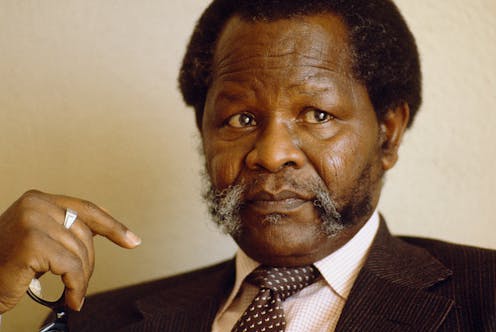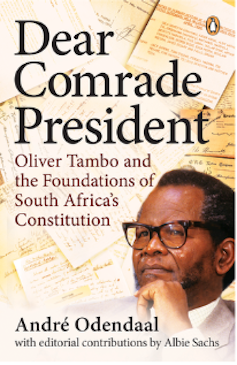
More than three decades have passed since the apartheid government in South Africa unbanned the African National Congress (ANC), the country’s leading liberation movement, and released its leader, Nelson Mandela, from prison. This launched four fraught years of negotiations and violence that led to South Africa’s first-ever democratic elections.
The book Dear Comrade President: Oliver Tambo and the Foundations of South Africa’s Constitution, by South African historian Andre Odendaal, focuses on a dimension ignored in previous histories and memoirs of this period: the ANC’s constitution-framing process, which would help to shape the future democratic South Africa.
In the mid-1980s conditions for negotiations to end apartheid did not seem promising. President PW Botha’s government had shifted control away from the white parliament towards the military. A wave of assassinations, proxy terror killings and regular raids on neighbouring states was launched.
On the ANC side, most felt the route to power was armed revolution. Its main sources of support were the then Soviet Union, German Democratic Republic and Cuba. Much of its leadership was beholden to Marxism-Leninism.
Odendaal quotes former South African Communist Party leader Joe Slovo saying (in 1994) that the political content of the ANC was “moulded” in these three countries – content Slovo calls “very mechanical Stalinist concepts”. Slovo adds:
Thinking back on it now it horrifies me to remember the kind of things they were taught.
This 442-page book unpicks the process of adopting constitutional principles that included support for multiparty democracy and a bill of rights. This process was launched by the ANC leader Oliver Tambo in 1985. It involved a seven-person constitution committee which eventually came up with a document that proved hugely influential in negotiations with the apartheid government.
Making of democratic South Africa’s constitution
The committee set up by Tambo drew up 14 drafts after many delays and much frustration. But it finally produced a document that was endorsed in 1988, and became the basis for the Organisation of African Unity and United Nations approach to South Africa.
This document guided the ANC’s stand in the negotiations under the umbrella of the Convention for a Democratic South Africa (Codesa). Odendaal writes:
A feature of the negotiating process was the way in which the ANC, with its more than four years of focused pre-planning, outmanoeuvred opponents determined to block democracy.
The most compelling bits of the book include profiles of the main players – Tambo and those on the committee, including Jack Simon, Kader Asmal, Zola Skweyiya, Albie Sachs and the man whose 1985 intervention set it in motion, Pallo Jordan.

Jordan’s paper , The New Face of Counter-Revolution, went against prevailing revolutionary wisdom. It argued that the ANC should take the initiative through backing multiparty democracy with a bill of rights guaranteeing individual freedom. It should also win the support of the black middle class.
Some within the ANC had severe doubts, worried this was getting in the way of revolution.
Challenging orthodoxy
Odendaal counters the view that it was the collapse of the Berlin Wall in November 1989 – marking the unravelling of the Soviet Union, the main backer of the ANC’s armed struggle – that nudged the ANC towards multiparty democracy. He shows it had already endorsed these principles more than three years earlier.
The collapse of the Soviet Union had “little impact on the ANC’s immediate thinking and strategy in relation to negotiations”, Odendaal adds. (In my view, it certainly had a longer-term impact, helping open the way for one-time Marxists to become multi-millionaires.)
Odendaal’s account also challenges the claim by some analysts, including Niel Barnard, the former head of the apartheid government’s National Intelligence Service, that the fall of communism allowed the government to negotiate. Odendaal acknowledges the collapse of the communist bloc made it easier for the government to unban the ANC. It also meant the government
could no longer rely on support from Western countries as a bastion against the supposed spread of communism.
But the process leading to negotiations was already unstoppable by then. The secret “Consgold talks”, aimed at easing the way towards negotiations, started in 1986. They were between the ANC and Afrikaner academics led by the Stellenbosch University philosophy professor Willie Esterhuyse, and backed by the National Intelligence Service.
Adding to the momentum were the talks Nelson Mandela held with apartheid justice minister Kobie Coetsee in 1986, and the government’s invitation to Soviet leader Mikhael Gorbachev to engage in discussions.
It’s often forgotten that it was the hardliner PW Botha, who preceded FW de Klerk as president, who met with Mandela and released Walter Sisulu and other political prisoners on 15 October 1989. The Berlin Wall came down on 9 November 1989.
Odendaal highlights the role played by the regular “safaris” that saw more than a thousand South African notables and activists meeting with the ANC between 1985 and 1990. This counters the view promoted by Barnard and Esterhuyse that these were irrelevant.
Instead, he suggests, they helped set the climate for negotiations by softening white South African attitudes to the ANC and widening ANC perspectives on conditions within the country. He quotes Barnard’s admission that these visits to the ANC in exile
were threatening to take over from the government so we had to act quickly.
Weaknesses and strengths
The book stresses that mass resistance and international sanctions pushed the apartheid government to the point where it had to negotiate. But its laser focus on the ANC’s constitutional process means that sometimes detail gets in the way of perspective, leading to too much listing of names and not quite enough contextual information.
For instance, Odendaal notes that the ANC was in “organisational disarray” by 1990. He also hints at the depth of the problems faced by the ANC’s army, Umkhonto we Sizwe (MK), referring to a meeting between Tambo and MK’s Ugandan camp commander Thenjiwe Mtintso, where she explains the dire conditions faced by recruits.
More could be said here. MK was decimated through being pushed out of its “forward areas” (its southern African bases), deeply infiltrated by apartheid agents and overwhelmed by internal problems under its compromised leader Joe Modise. Its other strand, Operation Vula (which involved establishing command structures within the country), was more successful but arrived too late to make a substantial difference to the balance of power between the ANC and the apartheid government.
These issues could have been explored in more depth even if it meant sacrificing some of the blow-by-blow detail.
Dear Comrade President might be hard going for the casual reader, but it makes a valuable contribution to the South African “struggle” library, revealing the importance of the constitutional process within the ANC for setting the trajectory of a democratic South Africa.
Gavin Evans does not work for, consult, own shares in or receive funding from any company or organisation that would benefit from this article, and has disclosed no relevant affiliations beyond their academic appointment.
This article was originally published on The Conversation. Read the original article.







